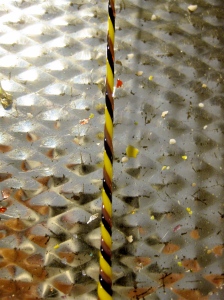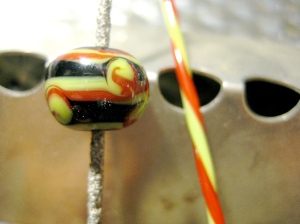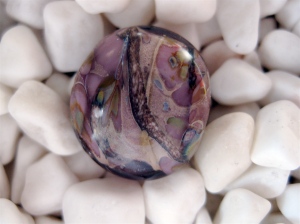
If you Google on “goddess bead,” you’ll see a lot of very lovely, female-shaped beads. Well, I actually have no desire to make a bead like that. My Goddess Beads were made specifically for a Sensual Goddess party I attended on Saturday night. There were to be seven of us, and besides eating, drinking, sharing poetry and stories, we also planned to share gifts.
I got myself in a Goddess Groove on Friday night, and sat at the torch for 3 hours, one of my longest sessions ever. I felt exhausted and energized at the same time when I finally shut down at 10:30 PM, beads soaking in the kiln to be revealed as successes or failures next morning. The beads were pretty large, and I’m always afraid large beads will crack from not staying properly hot while I work on them (between prepping* and working the glass, each bead took about 15-20 minutes to make). I was so happy to see all seven beads turned out crack-free, and quite pretty as well. I made them focal beads on various pieces of jewelry.
This was a great project for me, at this particular time. I’ve been wanting to free myself up and increase the intermixing of spirit, imagination, and technique. Flow, I will call it. Making a bead flow into a piece of jewelry is something I have been sidling up to until now. It all happened here, and it was thrilling.
The lampwork technique was inspired (and instructed) by Sarah Hornik, whom I’ve admired for a couple of years. During the course of making these seven beads, I became much more proficient with my marver, maintaining the cylindrical shape of the bead as I was working in the colors and stripes. My stringer application still sucks, but with this bead it doesn’t matter that much since the stripes get swirled. Mostly, my dots turned out okay, a couple were not “perfect” — but I was happy with them, overall.
Another thing that made me happy was that the holes were nice and “innied” — no jagged bits to grind off. I think this is because I kept marvering the bead to shape as I was working it.
*Prepping: Each bead required making color choices in advance and pulling stringers. The beads are composed of a cylindrical base bead in a light opaque color (pink, yellow, blue were my choices); the top half of the cylinder encased with rubino oro or other light-hued transparent glass (I used rubino oro, light red, and light yellow). After I chose base and transparent, I then pulled stringers complementary stripes applied to the base, for melting and swirling into flowy shapes, and then for dots in the last step. I tried to use different color combinations for each bead, but a couple of them turned out looking a bit similar. I was a little tired by the last bead, and used stringers I had pulled for previous beads, but in a different combination.








